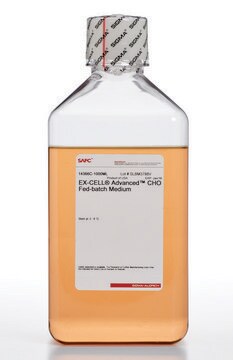Kluczowe dokumenty
14571C
EX-CELL® 293 Serum-Free Medium for HEK 293 Cells
Serum-free, Animal-protein free, without L-glutamine, liquid, suitable for cell culture
Produkcja farmaceutyczna
Synonim(y):
HEK 293 Medium
About This Item
Polecane produkty
Poziom jakości
sterylność
sterile; sterile-filtered
Formularz
liquid
metody
cell culture | mammalian: suitable (suspension)
komponenty
NaHCO3: yes
HEPES: no
L-glutamine: no
glucose: yes
Warunki transportu
ambient
temp. przechowywania
2-8°C
Szukasz podobnych produktów? Odwiedź Przewodnik dotyczący porównywania produktów
Zastosowanie
Informacje prawne
Kod klasy składowania
12 - Non Combustible Liquids
Klasa zagrożenia wodnego (WGK)
WGK 2
Temperatura zapłonu (°F)
Not applicable
Temperatura zapłonu (°C)
Not applicable
Wykazy regulacyjne
Wykazy regulacyjne dotyczą głównie produktów chemicznych. Można w nich podawać ograniczoną liczbę informacji na temat produktów niechemicznych. Brak wpisu oznacza, że żaden ze składników nie znajduje się w wykazie. Użytkownik odpowiada za zagwarantowanie bezpiecznego i zgodnego z prawem stosowania produktu.
EU REACH Annex XVII (Restriction List)
Wybierz jedną z najnowszych wersji:
Masz już ten produkt?
Dokumenty związane z niedawno zakupionymi produktami zostały zamieszczone w Bibliotece dokumentów.
Klienci oglądali również te produkty
Produkty
Eukaryotic cell lines aid in complex post-translational modifications and folding of recombinant proteins. Find suitable recombinant protein production cell lines at sigmaaldrich.com
Eukariotyczne linie komórkowe pomagają w złożonych modyfikacjach potranslacyjnych i fałdowaniu rekombinowanych białek. Znajdź odpowiednie linie komórkowe do produkcji białek rekombinowanych.
Nasz zespół naukowców ma doświadczenie we wszystkich obszarach badań, w tym w naukach przyrodniczych, materiałoznawstwie, syntezie chemicznej, chromatografii, analityce i wielu innych dziedzinach.
Skontaktuj się z zespołem ds. pomocy technicznej







